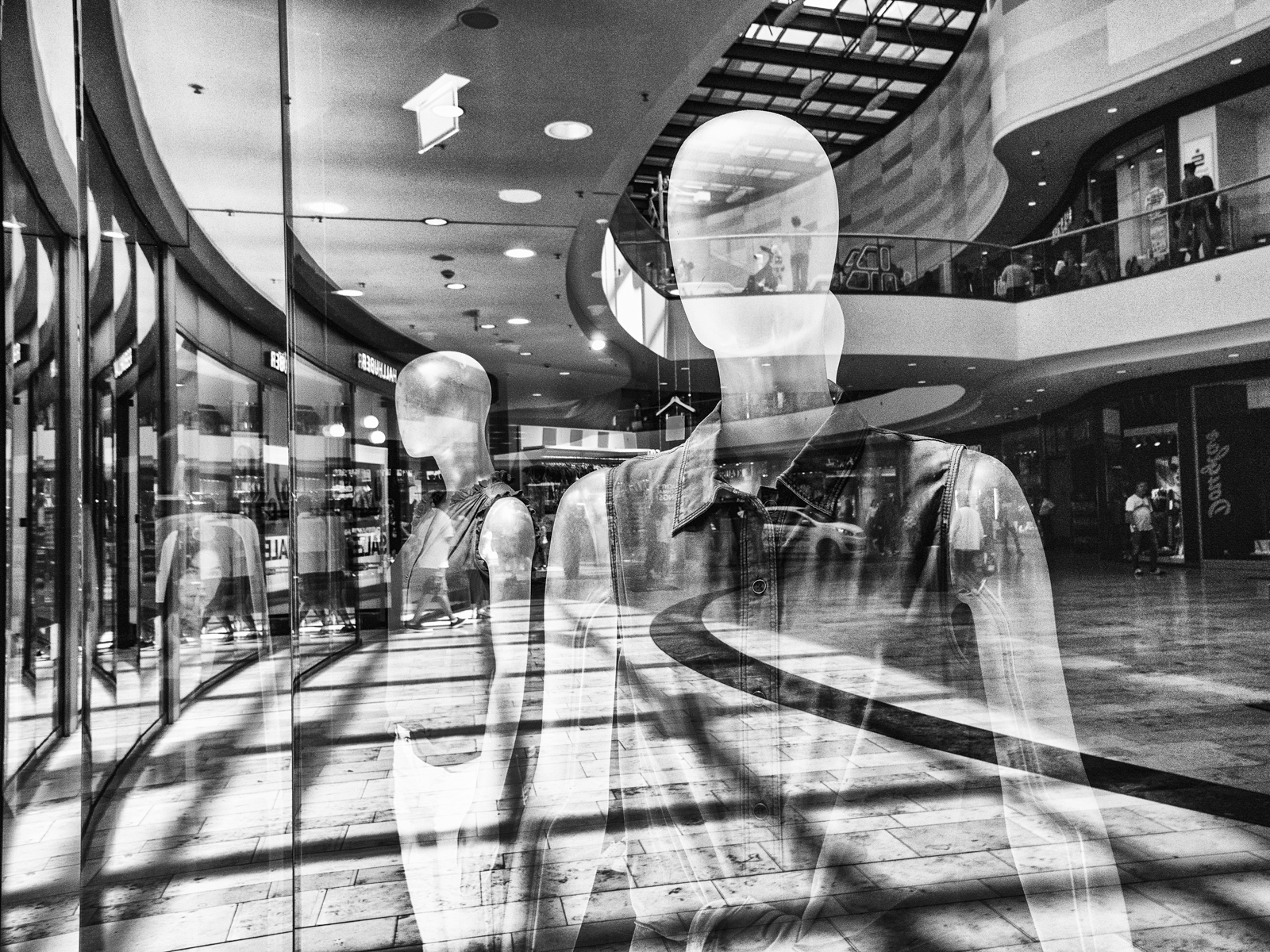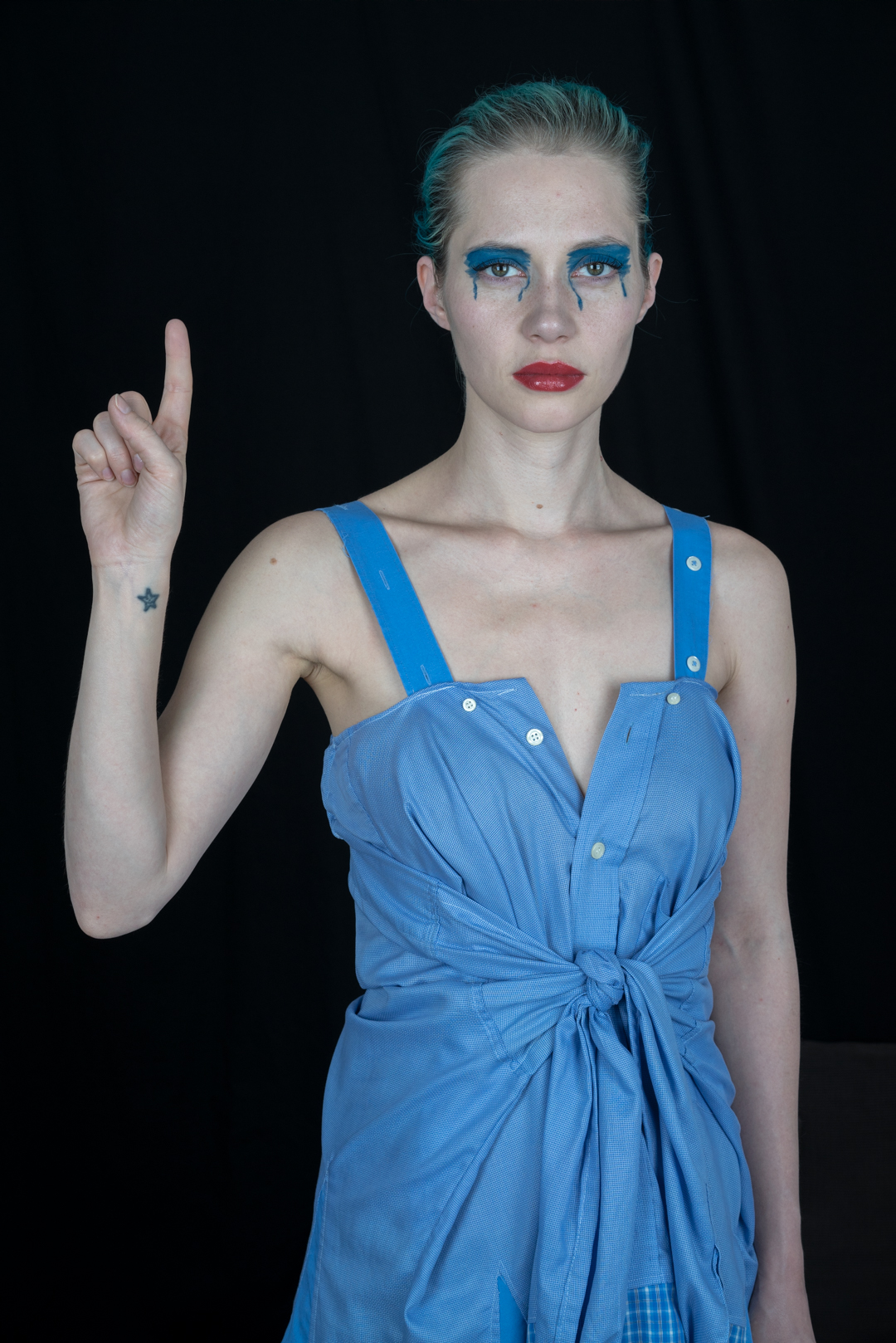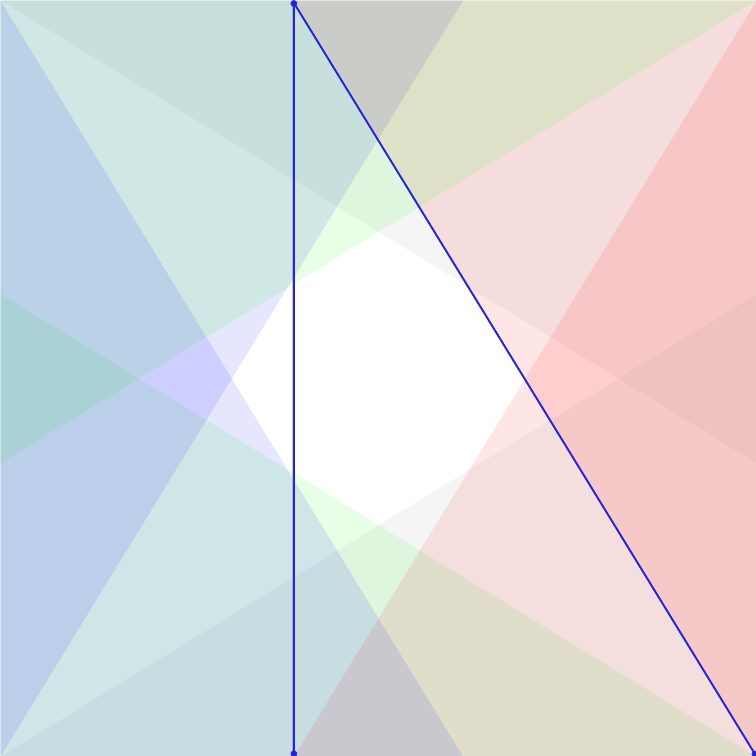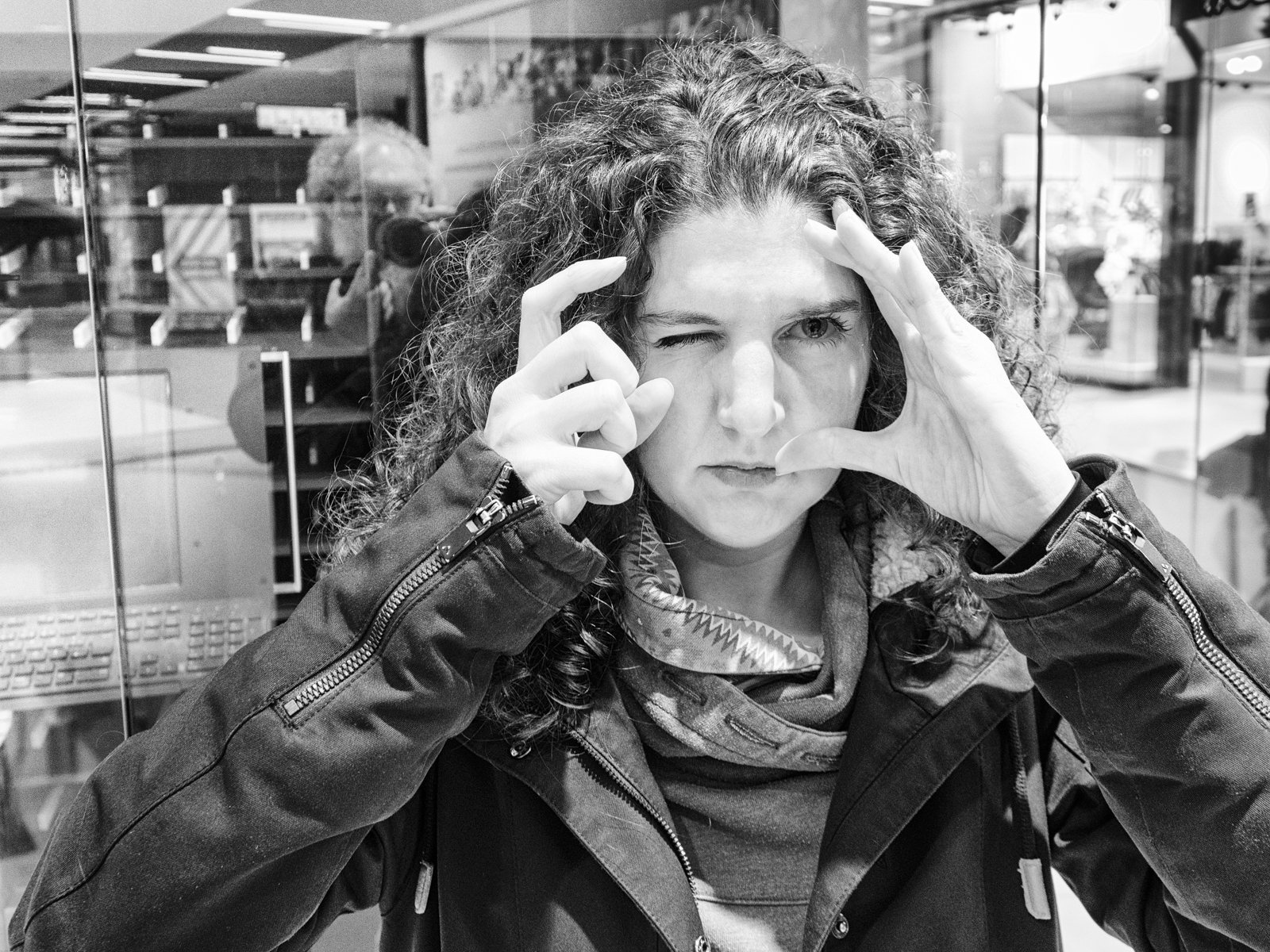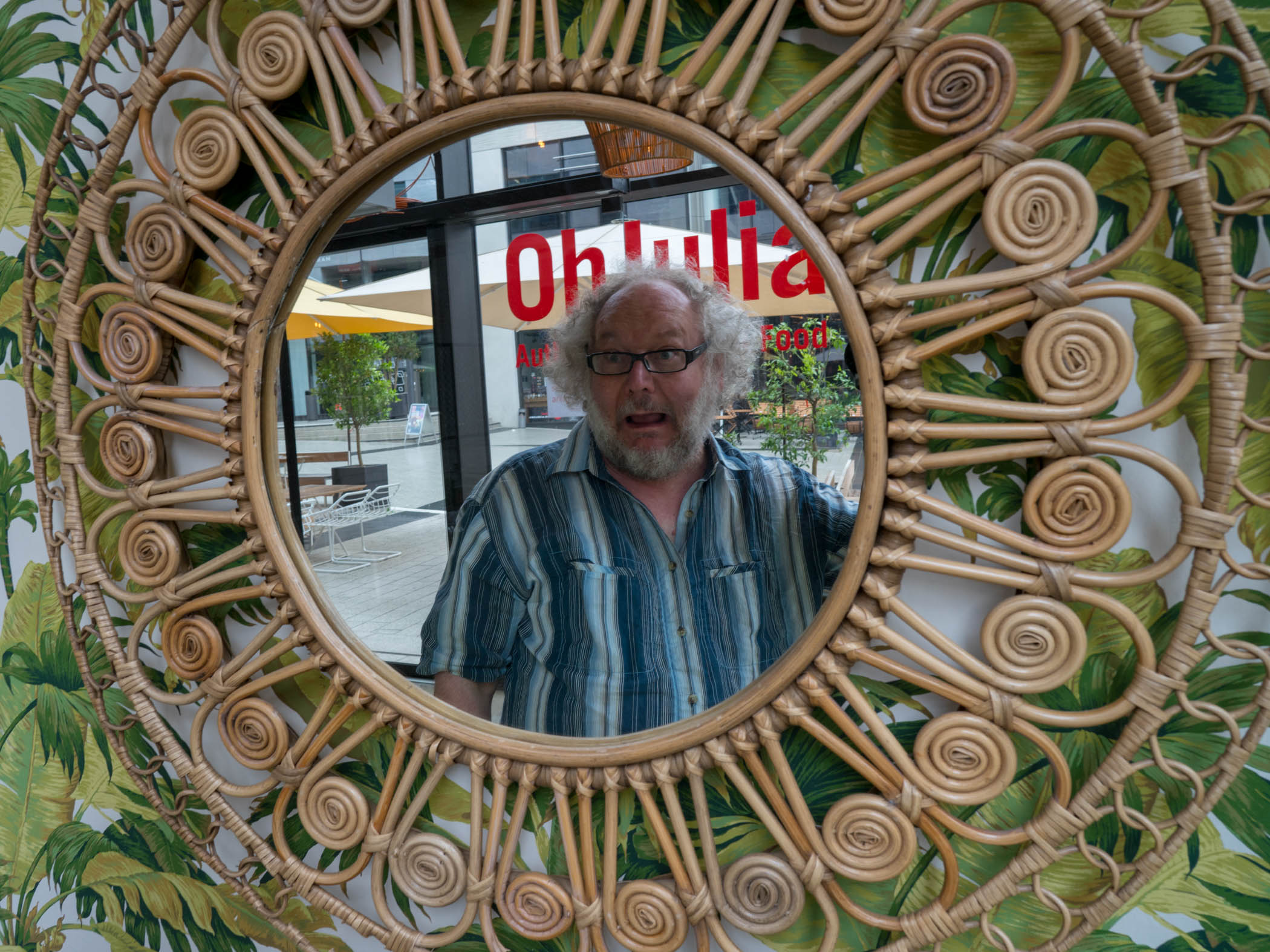
Der Wegweiser für kluge Avantgardisten als Welttheater
– Erzählt werden Geschichten in Form von Metalogen
Bild aus: Hannah Moser | ? | ? | 2022? |
Theatrum mundi 42 (TM42)
Die Bühne, die uns die Welt bedeutet
Theatrum mundi 42 ist die Medienplatform der Ateliers im Delta, auf der wir Carpe Diem et Noctem, Stadt der Vernunft, den Wegweiser für kluge Avantgardisten, Mein christliches Testament und die AiD Editionen von Hannah und Ralf Moser in Szene setzen.
Metalog der Meisterarchitekten der Wandelhalle in der Stadt der Vernunft des lebenslangen Lernens
Alice und Archi, die beiden Meisterarchitekten der Wandelhalle, stehen vor einer Tafel in ihrem gemeinsamen Atelier. Alice liest fassungslos den Text, den Archi auf die Tafel geschrieben hat.
Auf der Tafel steht:
Carpe Diem et Noctem – Ergreife den Tag und die Nacht – ist mehr als ein Aufruf zum Leben. Es ist ein künstlerisches Manifest, eine geistiger Orientierung und eine Einladung, die Welt in all ihren Facetten zu begreifen, zu gestalten und zu durchdringen.
Es ist Kunst über das Leben – über seine sichtbaren und unsichtbaren Metaebenen, seine Erkenntnisse, seine Lehren, seine Vielfalt, seine Gegensätze und seine ihm innewohnende Magie. Ein Spiegel der Existenz, der nicht nur das Licht des Tages, sondern auch die Tiefe der Nacht einfängt.
Es ist eine Kunstlehre, die sich mit den Künsten selbst beschäftigt – mit ihren Architekturen, ihren Konstruktionen, ihren Umsetzungen. Sie fragt: Wie entsteht Kunst, Kommunikation und Bedeutung? Wie wird das Unsagbare sichtbar?
Es ist eine Kulturlehre, die Kulturen nicht nur als historische Phänomene, sondern als lebendige Systeme versteht – mit ihren Glaubenswelten, Wissenschaften, Städten, Gemeinschaften und Ideen. Sie zeigt, wie Kulturen denken, fühlen, zusammen leben und handeln.
Es ist eine Glaubenslehre, die sich mit den innersten Überzeugungen der Menschheit auseinandersetzt – mit ihren spirituellen Architekturen, ihren symbolischen Konstruktionen und der Art, wie sie Wirklichkeit formen.
Es ist eine Wissenschaftslehre, die die Strukturen des Wissens erforscht – seine Erkenntnislehren, seine Systeme, seine Prinzipien. Sie fragt: Wie erkennen wir? Wie erklären wir? Wie gestalten wir Wissen?
Es ist eine Architekturlehre, die den Wissenstransfer von der Wissenschaft in die Praxis als Architektur begreift – mit Aufgaben, Funktionen und Kontexten. Sie analysiert, wie Aufgaben Kontexte schaffen, wie Gedanken Problem- und Lösungsräume formen und wie solche Räume Konstruktionen inspirieren.
Es ist eine Konstruktionslehre, die sich mit der Organisation von konstruktiven Lösungsprozessen beschäftigt – mit Funktionsstrukturen, Wirkprinzipien, Lösungswegen und ihren unendlichen Variationen. Sie ist die Kybernetik der Schöpfung und des Machens.
Und schließlich ist es eine Implementierungslehre, die Entscheidungen in Handlung verwandelt – die zeigt, wie Ideen zu Konstruktionen, zu Formen der Wirklichkeit werden, wie Visionen gebaut werden.
Carpe Diem et Noctem ist ein Ruf an alle, die tiefer sehen wollen. An Künstler, Denker, Träumer und Macher. Es ist ein Wegweiser durch das Labyrinth der Welt – bei Tag und bei Nacht.
Archi, Meisterarchitekt der Wandelhalle
in der Stadt der Vernunft des lebenslangen Lernens
[Alice, angepisst]: Du machst das immer wieder! Glaubst Du irgendjemand außer Dir und mir versteht, worum es bei Metaebenen, Kunst über Kunstlehren über Künste, ihre Architekturen, Konstruktionen und ihre Umsetzung oder bei irgendwelchen kybernetischen Modellbildungen als Grundlagen für den Geist und das Lernen geht? Das vermittelt einem noch nicht einmal das Gefühl zu verstehen, wenn man noch nichts von deiner heißgeliebten Architektur- Konstruktions- und Implementierungslehre oder unserer semantischen Maschine mit ihren semantischen Ketten gehört hat. Die Leute wollen mit Gefühl abgeholt werden. Da nutzt es auch wenig, dass Du deine formale, seelenlose Aufstellung durch einen KI-Bot gejagt hast, der schöpferische Seelen inspirieren soll.
[Archi, bockig]: Gefühl, Gefühl, Gefühl und nochmal Gefühl. Auch bei Gefühlen spielen Metaebenen eine große Rolle. Es gibt ja auch Metagefühle! Wenn Du mir auf der Objektebene immer das Gefühl gibst, zu versagen, dann entwickle ich auf der Metaebene durch mein intuitives Lernverhalten möglicherweise Versagensängste und deute zukünftige Herausforderungen und alles, was Du sagst, als Vorwurf des Versagens.
[Alice, belustigt]: Du kennst Versagensängste nur vom Hörensagen und genau das ist dein Problem. Guter Versuch, aber Du verstehst mich schon richtig.
[Archi, versöhnlich]: Deshalb haben wir die ganzen Metaloge ja so einfach wie möglich gemacht, aber nicht einfacher als möglich – ganz so wie Du es wolltest.
[Alice, amüsiert]: Vorsicht! Aufpassen!
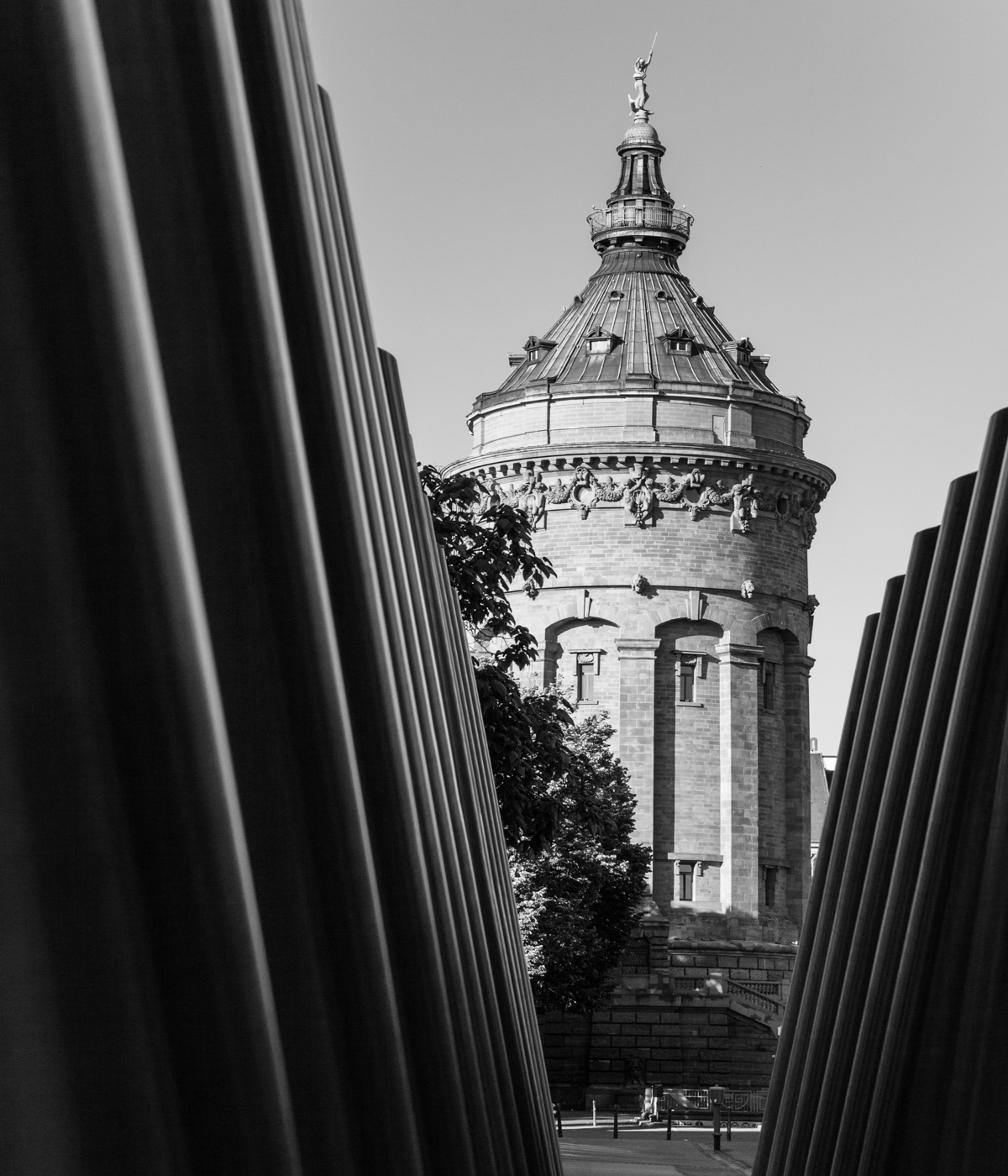
Stadt der Vernunft
Stadt der Vernunft setzt den erzählerischen Kontext für den Wegweiser für kluge Avantgarrdisten
Bild aus: Ralf Moser | Mannheim im Quadrat | Stadt der Vernunft | 2010 |
Bild aus: Ralf Moser | Mannheim im Quadrat |
Stadt der Vernunft | 2010 |
[Die allwissende Erzählerin, in der Rolle des allwissenden Erzählers auf der Metametaebene erzählend]: Die allwissende Erzählerin steht neben dem Rosengarten und blickt auf den Wasserturm der Stadt der Vernunft. Sie bereitet sich darauf vor, einen Metalog zu erzählen.
[Die allwissende Erzählerin, sich im Selbstgespräch an die Hierarchie von Metakontexten wendend]: Werden wir es in dieser Stadt schaffen, die Vernunft des lebenslangen Lernens zu etablieren?
[Kontext]: Wir sind kein Orakel!
[Metakontext]: Wir sind für dich eher eine Art von Selbstbetrachtung.
[Metametakontext]: Wir helfen Dir beim Lernen zu Lernen zu Lernen und so weiter.
[MAKEORBUY, der oberste Metakontext von allen]: Wir sind die Götter der Modellbildung und spiegeln deine Annahmen auf mehreren Ebenen mit einer Wahrheitssemantik als Architektur der aktuellen Situation. Das könntest Du mittlerweile wissen! Du bist nicht mehr die Stadtgöttin von Uruk sondern die Göttin des lebenslangen Lernens.
[Die allwissende Erzählerin, genervt]: Ich weiß.
[Die allwissende Erzählerin, schnippisch ans Publikum gewandt]: Na dann fangen wir einfach damit an, dass am Anfang kein Wort, sondern ein Kontext stand.
[Die allwissende Erzählerin, stolz]: Einst war ich in Uruk die mächtigste Gottheit von allen. Mein Name lautete Inanna und ich war die Herrin über Himmel und Erde, Leben und Tod. So mächtig war ich nicht von Anfang an, aber ich brachte zuerst den Tempel meines Urgroßvaters An aus dem Himmel in meine Stadt und danach holte ich mir die Weisheits- und Schicksalstafeln meines Großvaters Enki. Die Tafeln gaben mir die Herrschaft über alle anderen Götter und das Reich, das meine Stadt und meinen neuen Tempel umgab. Sie repräsentieren die erste Heilige Schrift, die erste Techne und ihre göttliche Vernunft.
[Die allwissende Erzählerin, mit dem Schalk im Nacken]: Es existieren keine früheren heiligen Schriften als die Sumerischen, da die Schrift erst zusammen mit den Tafeln erfunden wurde. Schrift und Tafeln kamen in meiner Stadt der göttlichen Vernunft zur vollen Blüte. Wer schreibt der bleibt, 😉 Deshalb ist es kaum verwunderlich, dass es über mich mehr Geschichten gibt, als über jede andere Gottheit der damaligen Zeit.
[Die allwissende Erzählerin, mit gemischten Gefühlen]: Aber meine Macht trug von Anfang an den Keim des Unfriedens in sich, da die erste Techne und ihre göttliche Vernunft auf der feudalen Herrschaftsordnung des sumerischen Götterrates basiert, an dem nur Götter teilnehmen dürfen, die von meinem Urgroßvater An dem Gott des Himmels abstammen und von seinem Samen sind. Meine Urgroßmutter ist Uraš die Göttin der Erde. Zusammen stellen sie möglicherweise die Verbindung zu den Namenlosen Göttern des heiligen Berges her, da gesagt wird, dass der Anfang von Himmel und Erde keinen Namen hat. Aber das ist eine andere Geschichte, die vom Anfang unserer Welt erzählt.
[Die allwissende Erzählerin, angepisst]: Nach uns kopierten viele andere euch besser bekannte Gottheiten unsere Taten. Ich wurde immer unzufriedener, weil die Entwicklung nicht zu einer besseren Welt führte. Ich schwor den namenlosen Göttern und den Metakontexten des Anfangs in Zukunft für ein lebenslanges Lernen zu werben. Angepisst von meiner eigenen Macht und Einflussnahme, gab ich meine Führungsrolle auf und hoffte auf eine neue Techne, die allen das lebenslange Lernen und echte Entscheidungsfreiheit ermöglicht, eine Techne, die Orientierung durch alternative Möglichkeiten vermittelt, ohne Einfluss auf die persönliche Wahl der Alternativen zu nehmen.
[Die allwissende Erzählerin, hoffnungsvoll]: Die Weisheits- und Schicksalstafeln verschmolzen mit mir zur Trinität des epischen Kontextes und es entstanden weitere lange Geschichten, die mich von Uruk über Babylon, Athen, Rom und dann durch das Heilige Römische Reich in die zukünftige Stadt der Vernunft des lebenslangen Lernens führen sollten. Hier und jetzt erzähle ich die Geschichten von Alice und Archi, den Meisterarchitekten der Wandelhalle. Sie haben geschworen eine neue Techne zu entwickeln, die eigene unbeeinflusste Entscheidungen leicht und Einflussnahme schwer macht, ohne dabei das Dazulernen zu behindern. Sie fördert den Sinn im Leben zu suchen. Dazu betrachtet sie die Architektur des eigenen Lebens und füllt es mit sinnstifteten Aufgaben. Dagegen sieht sie alle idealisierenden Systeme, die den Sinn des Lebens suchen, kritisch, weil idealisierende Systeme auf fehlerhafte Weise verallgemeinern. Die neue Techne macht deshalb aufgabenbezogene, individuelle Fortschritte, die für jeden zu einer besseren Welt führen, leicht aber den klassischen Rationalismus, der für ein Problem nur eine ideale Lösung kennt, schwer.
[Die allwissende Erzählerin, schwärmerisch]: Eine solche Techne erlaubt es Organisationen, Gemeinschaften und Individuen technologisches Wissen aus der Wissenschaft so in die Praxis zu transferieren, dass es allen Menschen neue Möglichkeiten schafft, ohne dabei Einfluss auf die Wahl der Möglichkeiten zu nehmen. Eine solche Techne begrenzt den Glauben an falsche Ideale, die dort Verallgemeinern, wo die Wünsche der Menschen unterschiedlich sind. Sie transferiert Einflussnahmen der Sozialwissenschaften, der „Begründungs-Philosophien“, der religiösen Weltbilder, der Postmoderne und anderer Denksysteme mit idealistisch-.religiösen Wurzeln zu Informationen über Möglichkeiten, die Orientierung ohne Einflussnahme bringen. Sie macht gute Politik in gesellschaftlichen Kontexten von Bündnissen, Staaten, Ländern, Städten, Gemeinden und Organisationen auf demokratische Weise leicht und schlechte Politik, die nicht die Interessen aller gesellschaftlichen Gruppen im Blick hat, schwer. Die neue Techne ermöglicht eine soziale Steuerung, die den Raum für gemeinschaftliche und individuelle Entscheidungen in einer Hierarchie von Kontexten so einengt, dass gemeinschaftliche Entscheidungen demokratisch mit dem Blick auf alle gesellschaftlichen Gruppen und individuelle Entscheidungen in Freiheit getroffen werden können.
Der Wegweiser für kluge Avantgardisten hat drei Teile, die das technologische Fundament für unsere Kognition legen:
- Eine Erkenntnislehre der Erkenntnis und der Kognition: Was ist Wahrheit, Vernunft und Realität?
- Was ist Wahrheit?
- Was ist Vernunft?
- Was ist Realität?
- Eine Erkenntnislehre des Lebens, Entscheidens und Handelns: Was ist Geist, Kunst und Kultur?
- Was ist Geist?
- Was ist Kunst?
- Was ist Kultur?
- Eine Erkenntnislehre des Herstellens: Was ist Architektur, Konstruktion und Umsetzung?
- Was ist Architektur?
- Was ist Konstruktion?
- Was ist Implementierung?
[Archi, nachdenklich]: Die Gliederung ist zwar einfach zu verstehen, macht aber nicht deutlich, dass unter jedem Gliederungspunkt von uns neu entwickelte Techniken gibt, die es erleichtern, den Sinn im Leben selbst zu suchen und dem eigenen Leben einen selbstgewählten Sinn zu geben.
[Alice, im genervten Ton der nerdigen Venus]: Da müssen wir darauf vertrauen, dass sich die Besucher unserer Internetseite manches selbst aus dem erzählerischen Kontext der neuen Techne erklären. Das ist ja der Charme unserer Lösung, dass alles in einem situativen Kontext passiert, der sich aus theoretischen, technologischen, technischen, entscheidungsbezogenen, handlungsbezogenen und politischen Kontexten bildet, die zusammen den Entscheidungsspielraum der Situation einengen, bis sich die reale Situation im Fluss der Zeit zeigt.
[Archi, schelmisch]: Wie poetisch! Schön gesagt, aber meinst Du, dass alle ohne weitere Erklärung verstehen, dass die theoretischen, technologischen und technischen Kontexte in objektiver Weise aus allen logischen Möglichkeiten der Situation jene ausschließen, die jeder beliebigen Person in der Situation nicht zur Verfügung stehen? Und dass sie deshalb dem Konzept der objektiven Wahrheit zugänglich sind. Meinst Du dass, die entscheidungsbezogenen, handlungsbezogenen und politischen Kontexte es Individuen in Organisationen, Gesellschaften und Gemeinschaften als Entscheidungsträger ermöglichen, aus den verbleibenden Möglichkeiten durch Entscheidungen, Handlungen und ihre Politik jene zu wählen, die ihren Zielen und Wünschen am ehesten entsprechen? Und dass im Fall einer einzelnen Person, das Konzept der objektiven Wahrheit nicht darauf hinausläuft, dass wir alle gleich sind und alle die gleichen Entscheidungen fällen und das Gleiche tun, sondern, dass wir objektiv hinterfragen, ob unsere Entscheidungen und Handlungen unseren Zielen und Wünschen entsprechen oder ob wir uns selbst belügen. Dabei gilt die objektive Gültigkeit der gewählten Ziele und Wünsche nur im Kontext der betrachteten Person und kann nicht verallgemeinert werden. Ein solches Konzept der objektiven Wahrheit, ist für unsere Lernverhalten grundlegend und zeigt die Naivität der subjektiven Wahrheit auf.
[Alice, ernst]: Nein, das meine ich nicht. Ich meine um die Zusammenhänge zu verstehen, dürfen wir es ihnen nicht wirklich leicht machen. Sie müssen lernen, dass es keine Abkürzungen oder leichten Wege gibt, um mit dem Sinn im Leben, der Architektur des eigenen Lebens oder dem Sinn der selbstgewählten Aufgaben umzugehen. Um die notwendigen Anstrengungen anzugehen, brauchen sie die Sehnsucht, die Zusammenhänge verstehen zu wollen, ohne sich dabei selbst zu belügen. Es ist so schwer, sich dafür zu entscheiden, sich um die Architektur und die Kontexte des eigenes Lebens selbst zu kümmern und sich nicht einfach auf eine frohe Botschaft mit einem idealisierten Sinn des Lebens einzulassen. Lebenskrisen helfen natürlich auch.
[Archi, nachdenklich]: Du meinst also, nur eine große Sehnsucht nach einem selbst bestimmten Leben oder Lebenskrisen treiben Menschen dazu, alle Einflussnahmen zu hinterfragen. Nur dann, wenn wir wirklich unser Leben selbst in die Hand nehmen wollen, verstehen wir den Segen von Architekturschemata, die aus Kontexthierarchien aufgebaut sind und in denen sich alle Kontexte als Lehren aufbauen lassen. Nur solche Lehren bringen Orientierung ohne Einflussnahme mit sich.
[Alice, ernst]: Es ist ein schwerer Weg, den viele scheuen, und es hilft nicht, mit der Tür ins Haus zu fallen und alle Zusammenhänge gleich am Anfang zu erklären. Insbesondere jenen, die bereits in einer Lebenskrise stecken, hilft das nicht. Es ist besser sich erst aus der Krise helfen zu lassen und dann Stück für Stück vorzugehen, um es zukünftig besser zu machen. Deshalb haben wir den Wegweiser in drei Teile aufgeteilt. Das ist schwer genug und es braucht Zeit und Geduld.

Wegweiser – Wahrheit, Vernunft und Realität
Im ersten Teil des Wegweisers geht es um die Architektur der Wahrheit, der Vernunft und der Realität
Bild aus: Ralf Moser | Die Wandelhallen des ewigen Donners |
Die aristotelischen Wurzeln von Wahrheit und Vernunft |
Definition der Wahrheit | 2013 |
Ebenso wenig aber kann zwischen den beiden Gliedern des Widerspruchs etwas mitten inne (metaxý) liegen, sondern man muss notwendig jedes von jedem entweder bejahen(phánai) oder verneinen(apophánai). Dies erhellt zuerst aus der Bestimmung der Begriffe wahr und falsch.
Zu sagen nämlich,
das Seiende sei nicht oder
das Nicht-seiende sei, ist falsch,
dagegen zu sagen,
das Seiende sei und
das Nicht-seiende sei nicht, ist wahr.
Wer also ein Sein oder Nicht-sein prädiziert, muss Wahres oder Falsches aussprechen.
Aristoteles
[Alice, amüsiert]: Na wer wie Pilatus fragt, was ist die Wahrheit, steckt sicherlich in einer tiefen Krise.
[Archi, schmunzelnd]: Ja und er hat bis heute keine umfassende Antwort bekommen.
[Alice, belustigt]: Da bin ich aber froh, dass wir eine umfassende Antwort haben, wenn man sich den Wegweiser – Wahrheit, Vernunft und Realität ansieht, und hier eine relativ einfache haben.
[Alice, amüsiert]: Mit semantischen Ketten ist die Antwort quasi ein Kinderspiel!
Ralf Moser | Wegweiser für kluge Avantgardisten |
Was ist die Wahrheit |
Denkzettel – Semantische Ketten | 2020 |
[Alice, begeistert]: Manche unserer Denkzettel, lassen sich herunterladen. Andere muss man für einen guten Zweck kaufen. Wenn sie gedruckt sind, lassen sie sich an eine Leine klammern, und dann sieht es aus wie bei einem Gelehrten in früheren Zeiten. Zum Lesen nimmt sie wieder von der Leine ab und liest in Ruhe unsere Metaloge .
[Archi, schelmisch]: Vielleicht sollten wir jetzt doch auf eine wichtige Hürde zu sprechen kommen, die auf dem Weg jedes klugen Avantgardisten liegt. Eine der großen Hürden ist, dass heute nur Sprache formal wahrheitsfähig ist. Es gibt eigentlich keine formale Wahrheitsdefinition für Bilder. Aber die semantischen Ketten in unserer semantischen Maschine können das ändern. Semantische Ketten sind ein Unterschied, der einen Unterschied macht. 😉
[Alice, konzentriert auf ihr Tablet blickend]: Vielleicht sollten wir zunächst den Zusammenhang zwischen Fotografien, Karten, der Realität und der Modellbildung unserer neuen Bedeutungslehre vertiefen. Unsere semantischen Ketten erfassen den bezeichneten Zusammenhang auf eine neue, formale Art und Weise. Damit sind wir jetzt so weit, die objektive Wahrheit nicht nur für Sprachen, sondern auch für Messungen und damit für Bilder zu klären.
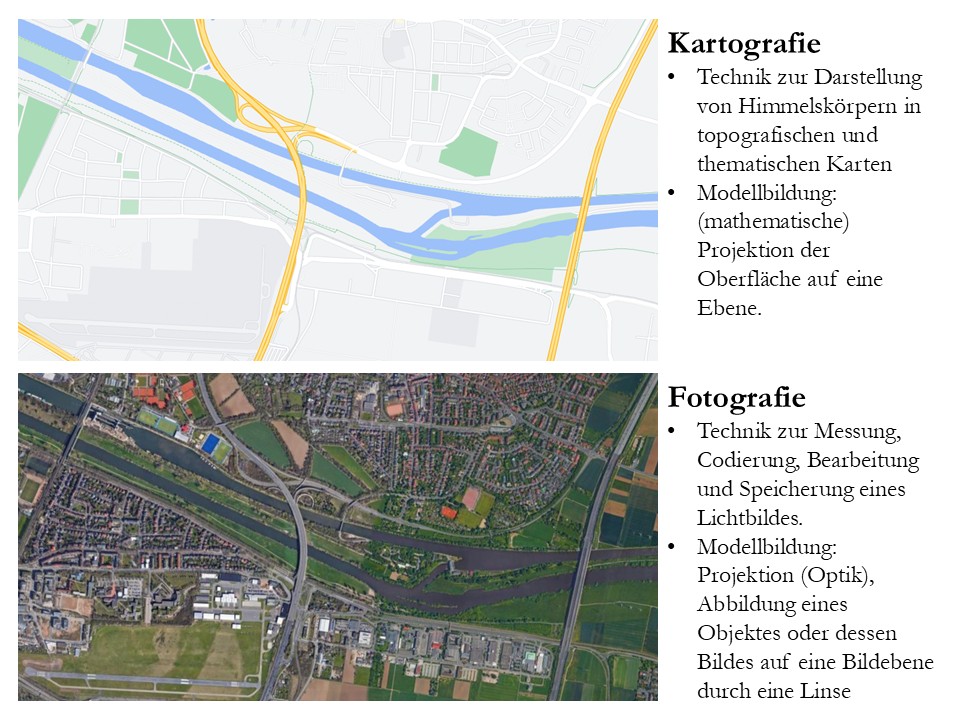
Ralf Moser | Vorbereitender Metalog über die objektive Wahrheit |
Denkzettel 2022 |
[Archi, ernst]: Vielleicht sollten wir vorher noch deutlich machen, wie gemessene Daten zu Informationen in Kommunikationsmedien werden. Aristoteles war der Erste, der Medien als eigenständige Instanz und als Vermittler von Informationen sah und den Begriff der Medien prägte. Und letztendlich machen semantische Ketten Bilder wahrheitsfähig, weil sie als Kommunikationsmedien Informationen tragen. Das ist später für unser Verständnis von Kunst sehr wichtig, weil jede Kunst ein Kommunikationsmedium ist. Zumindest in diesem Punkt sind sich heute alle die Meisten einig.
[Alice, motiviert auf ihr Tablet blickend]: Gute Idee für den Einstieg ins Thema! Also, die verschiedenen Kartendienste sind auf meinem Tablet ein abrufbarer Service, der auf verschiedenen Kommunikationsmedien wie Fotografien, Karten und Texten basiert. Jede Kommunikation basiert auf Messungen, deren Daten in Modellbildungen verarbeitet werden. Bei der Fotografie wie bei der Kartografie basieren die Messungen auf Modellbildungen der Optik. In einem Fall ergeben die gemessenen Daten eine Fotografie und im anderen Fall eine Karte. Karte und Fotografie sind Informations- und Datenträger sowie Kommunikationsmedien, die unterschiedliche Informationen über das vermessene Territorium tragen. Die Informationen sind zu Daten geworden und können verarbeitet und gespeichert werden.
[Archi, konzentriert]: Wer die Karte und die Fotografie vergleicht, sieht, dass in der Fotografie und der Karte das gleiche Territorium dargestellt wird. Kartografie ist eine Ingenieurwissenschaft zur Darstellung von Himmelskörpern in topografischen und thematischen Karten – also Landkarten, Wanderkarten, Straßenkarten, Radkarten und so weiter. Die Karten vermitteln die raumbezogenen Informationen als Kommunikationsmedien für verschiedene Zielgruppen und enthalten insbesondere Informationen für die intendierten Zwecke der Karten. Wanderkarten beinhalten insbesondere Wanderwege, Radkarten insbesondere Radwege, Straßenkarten insbesondere Straßen und so weiter. Die Informationen können objektiviert werden, weil sie – ohne Einfluss zu nehmen – für alle die gleichen Möglichkeiten aufzeigen. Fotografien enthalten Informationen, die durch die Optik der Kamera im Aufnahmeprozess auf der Bildebene sichtbar gemacht werden.
[Alice, im Ton der nerdigen Venus]: Beispielsweise ist der Weg, auf dem wir immer von Feudenheim über die Fußgängerbrücke unter die Carlo-Schmid-Brücke laufen, in der Fotografie nicht sichtbar, weil er unter Bäumen liegt. Aber in der Karte ist der Verlauf des Weges sichtbar. Auf beiden umfasst das Territorium zwei große und zwei kleine Brücken, die sowohl in der Fotografie als auch in der Karte gut erkennbar sind. Die beiden Großen unterscheiden sich dadurch, dass die eine gerade verläuft und die andere einen Bogen macht. Die beiden kleineren Brücken unterscheiden sich noch dadurch, dass die Eisenbahnbrücke links oben deutlich größer ist als die kleinste Brücke, die sich in der Mitte befindet.
[Archi, im lässigen Ton des Meisterarchitekten]: Wir lernen: Wer in Fotografien und Karten wie in Plänen lesen kann, hat mit der Orientierung im Leben kein Problem mehr, weil er Informationen aus verschiedenen Bildern zur Ortsbestimmung und Orientierung herauslesen und verbinden kann. Ein solcher Prozess kann objektiviert werden, weil die zugrundeliegenden Techniken, für jeden gleich funktionieren und die gleichen Informationen liefern kann. Die Karte und die Fotografie spiegeln das Territorium für einen bestimmten Zeitpunkt und können Irrtümer, Täuschungen und Messfehler enthalten, aber der semantische Prozess, Karte und Territorium in Einklang zu bringen, macht Abweichungen und Fehler erkennbar.
[Alice, verschmitzt]: Viele suchen nur Informationen, die zu ihrem Glauben, ihren Vorstellungen und ihren Interessen passen. Auch die Informationen können an Interessen gebunden sein. Das macht sie aber nicht subjektiv, sondern nur unvollständig, irrelevant, nicht nachprüfbar, irreführend und damit mehr oder weniger nützlich für die unbeeinflusste Orientierung in den Möglichkeiten, die unsere Realität in einem von uns betrachteten Kontext zu bieten hat. Möglicherweise werden wir bei der Suche nach Informationen sogar ausspioniert, um uns zu hintergehen, besser beeinflussen zu können oder schlimmeres; aber dennoch setzen wir uns die subjektiven Scheuklappen selbst auf, wenn wir nicht sehen, dass Idealisierungen Einflussnahmen im Gewand des Glaubens auf unsere Entscheidungen sind.
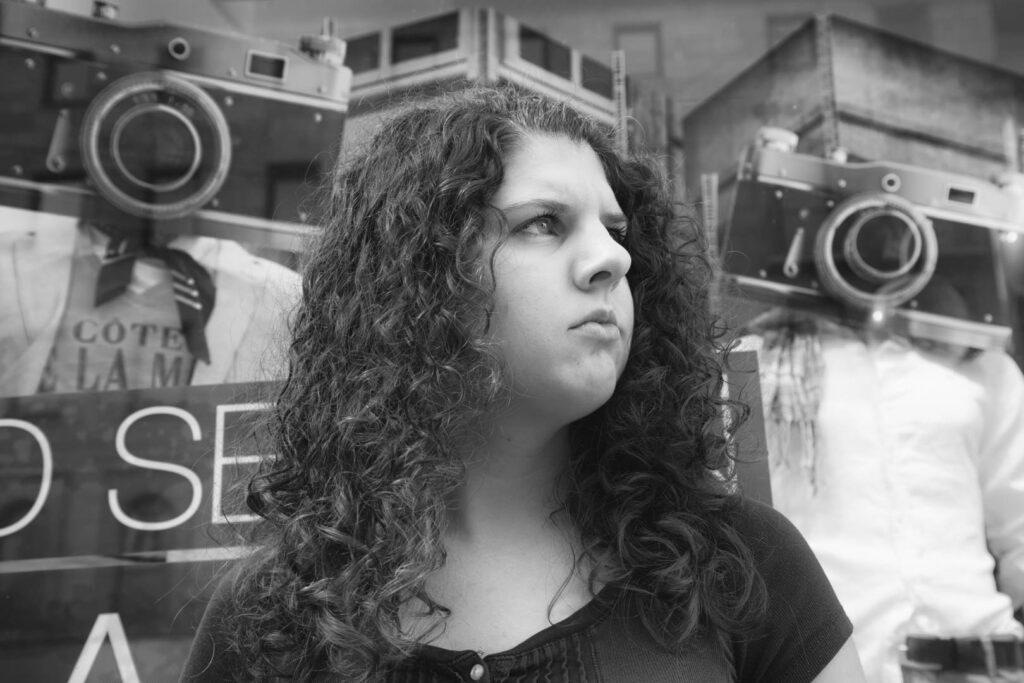
Hannah Moser | Werde ich von Maschinen beobachtet? |
Was beobachtet mich, wenn ich durch die Stadt gehe? | 2012 |
[Archi, amüsiert]: Ja, das ist die Pointe bei der Betrachtung der Realität und der objektiven Wahrheit: zu verstehen, dass die Grenze zwischen objektiven Möglichkeiten und Möglichkeiten, die bereits durch subjektive Entscheidungen eingeschränkt wurden, die Grenze ist, zwischen Möglichkeiten, die in jedem Kontext für alle objektiv wahr sind, und ausgewählten Möglichkeiten, die nur im Kontext einer Gemeinschaft, einer Organisation oder einer Person objektiv wahr sind. Bei einer Person prüft die objektive Wahrheit lediglich, ob sich die Person mit ihrer subjektiven Wahl selbst belügt oder ob die subjektive Wahl in ihrem Kontext objektiv mit ihren Gefühlen, Wünschen, Vorlieben und so weiter übereinstimmt. Wer über persönliche Kontexte hinweg verallgemeinert oder ihre objektiven technischen Möglichkeiten einschränken will , nimmt Einfluss. Das ist in der Erziehung und der Politik notwendig, aber man sollte ein Mandat haben und es ist empfehlenswert zu lehren und nicht zu idealisieren.
[Alice, ernst]: Klar kann ich, wenn ich durch die Stadt gehe, fotografiert und ausspioniert werden. Was solls? Wichtiger ist es, die kybernetische Modellbildung der Kontexthierarchie als Architekturschema und die Bedeutung des Architekturschemas mit seinen Metaebenen des Lebens für das Lernen zu verstehen. Ein Individuum entscheidet und handelt immer in einem individuellen Kontext. Subjektive Wahrheiten sind hinsichtlich unseres Lernverhaltens geradezu eine naive Vorstellung für die Funktion der Wahrheit. Bei Entscheidungen und Handlungen kommt es darauf an, sie für sich selbst zu hinterfragen. Unsere Denkzettel fördern das Lernverhalten und sind ganz einfach, zu verstehen – quasi ein Kinderspiel.
[Archi, amüsiert]: Jetzt hast aber Du die Kinderspiel-Sache ins Spiel gebracht!
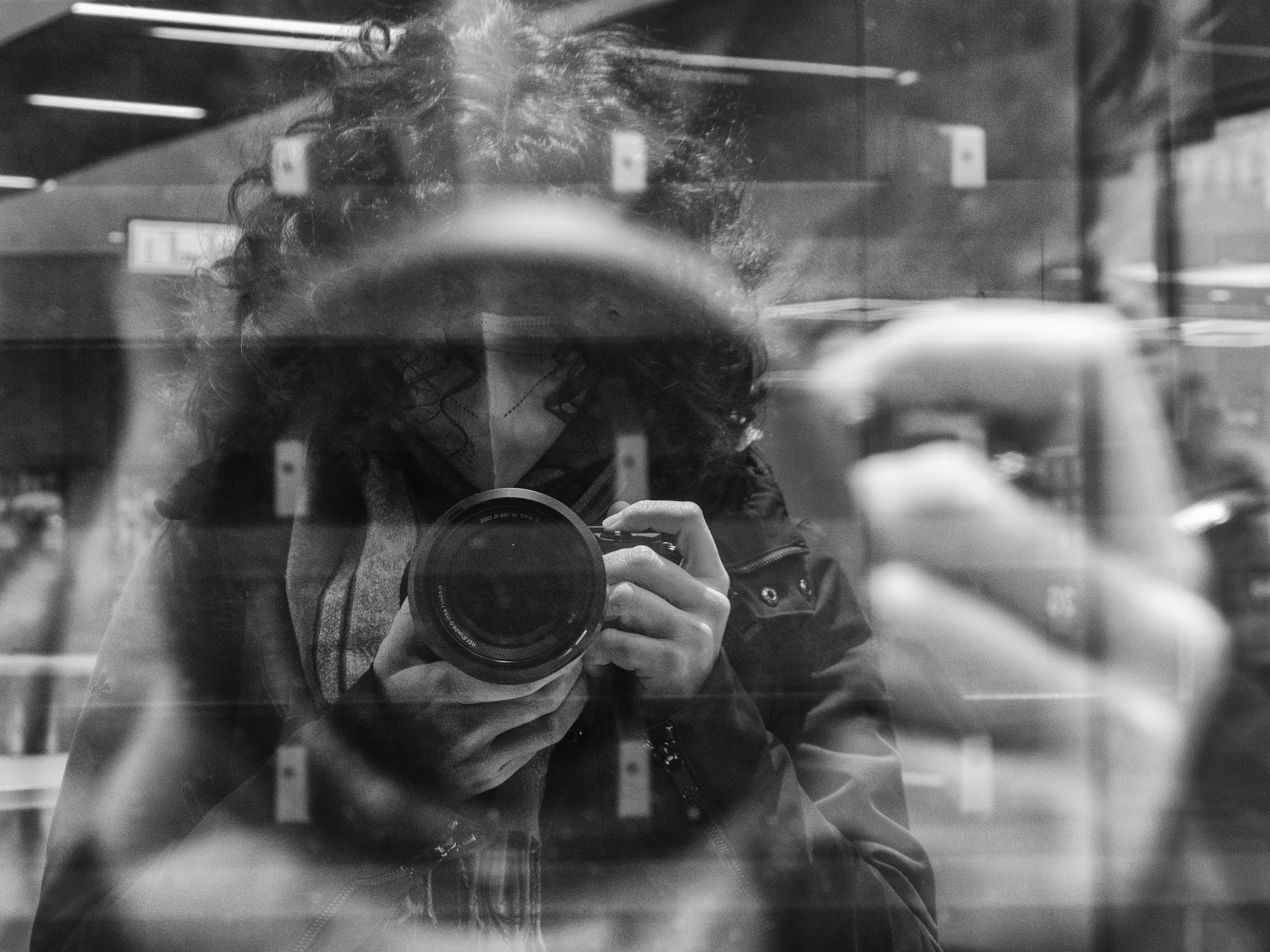
Wegweiser – Geist, Kunst und Kultur
Im zweiten Teil des Wegweisers geht es um die Architektur des Geistes, der Kunst und der Kultur
Bild aus: Hannah Moser | Looking at myself through the lens – Looking forward |
Through the Lens | 2020 |
[Alice, nachdenklich]: Hier würde ich mir tatsächlich wünschen, dass deutlicher wird, dass wir mit Architektur des Geistes alle Sinne, alle Informationsverarbeitenden Funktionen des Unterbewusstseins und des Bewusstseins und alle sprachlichen Funktionen des Ich und seines Selbst meinen. Selbst dann wird nicht deutlich, dass « [Alice, nachdenklich]: Hier … » eine Äußerung des Kontexts meines Selbst an den mich umgebenden Kontext ist, der beispielsweise durch meine Stimme verrät, dass ich gerade nachdenklich bin.
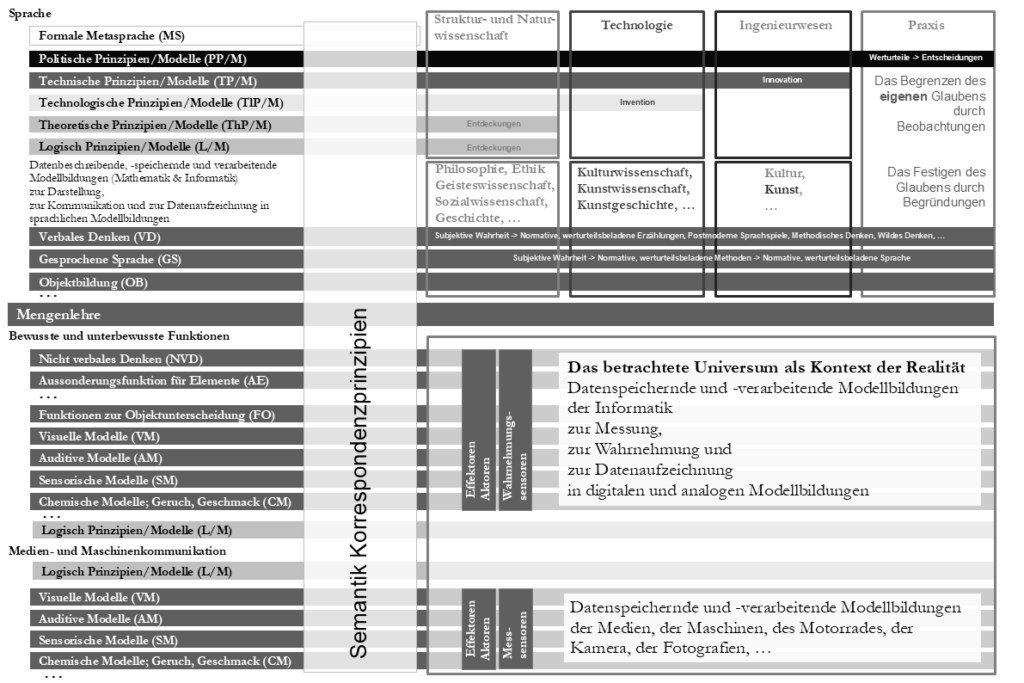
Ralf Moser | Die Architektur des Selbst als persönlicher Kontext des Ichs |
Denkzettel 2022 |
[Archi, schmunzelnd]: Jetzt fehlt nur noch, dass Du dir dabei wünschst, dass deutlich wird, dass Du dich dabei auf mehreren Ebenen selbst beobachten und deine Wahrnehmung und dein Selbst dabei neu kalibrieren und neu ausrichten könntest. Vielleicht sogar, dass die Selbstbeobachtung über mehrere Metaebenen mittels spiegelnden Ebenen, Fotografie und Video jene kybernetische Modellbildung bezeichnet mit der man dazu lernt. Und als Sahnehäubchen, dass dazu die Funktion deines Geistes notwendig ist, dass Du dich selbst erkennen kannst.
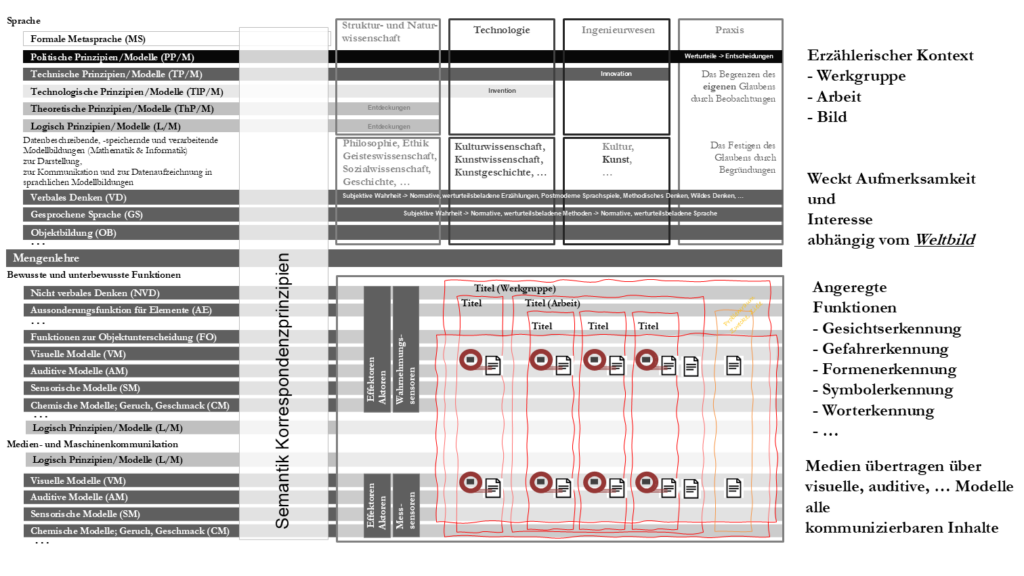
Hannah und Ralf Moser |
Die Konstruktionsstückliste einer Werkgruppe im persönlichen Kontext des Betrachters |
Denkzettel 2022 |
[Alice, belustigt]: Da wäre mir wichtiger, dass deutlich wird, dass Beobachter ihr eigenes Beobachten simultan beobachten können und dass Beobachtung zweiter Ordnung nur dann, eine Beobachtung ist, wenn sich erklären lässt, wie der Beobachter über seine Beobachtung durch Wahrnehmungsfunktionen mit der Realität verbunden ist. Unsere semantische Ketten bauen dazu semantische Korrespondenzprinzipien auf, aber Luhmann und alle die sich auf Spencer-Brown und seine Algebra beziehen, beobachten sich nur beim Spielen mit Sprache und Modellbildung.
[Archi, verschmitzt]: Meinst Du, dass viele die Voraussetzung von Luhmanns System- und Kunsttheorie kennen. Meinst Du, dass sie wissen, wie die radikalen Konstruktivisten und er sich auf Spencer- Brown beziehen. Dass Spencer-Brown die Modellbildung idealisiert und mystifiziert und die Idee der Wahrheit für die Modellbildung leugnet.
[Alice, amüsiert]: Nein, aber ich hoffe, dass alle es in Zukunft leichter haben, es sich schwer zu machen und dass sie sich mit unserer semantischen Maschine auseinandersetzen und dass sie ein anderes Verständnis von Kunst und Kultur bekommen; ein Verständnis, das alle Funktionen der Wahrheit für die Kommunikation und das Lernen in und über kybernetische Kontexte versteht. Und ich hoffe, dass die meditative Kunst von Carpe Diem et Noctem dazu beiträgt, dass viele verstehen, dass sie ein neues Verständnis für die Kultur und das lebenslange Lernen mit sich bringt. Erst dann, macht es eigentlich Sinn über Kultur zu reden. 😉
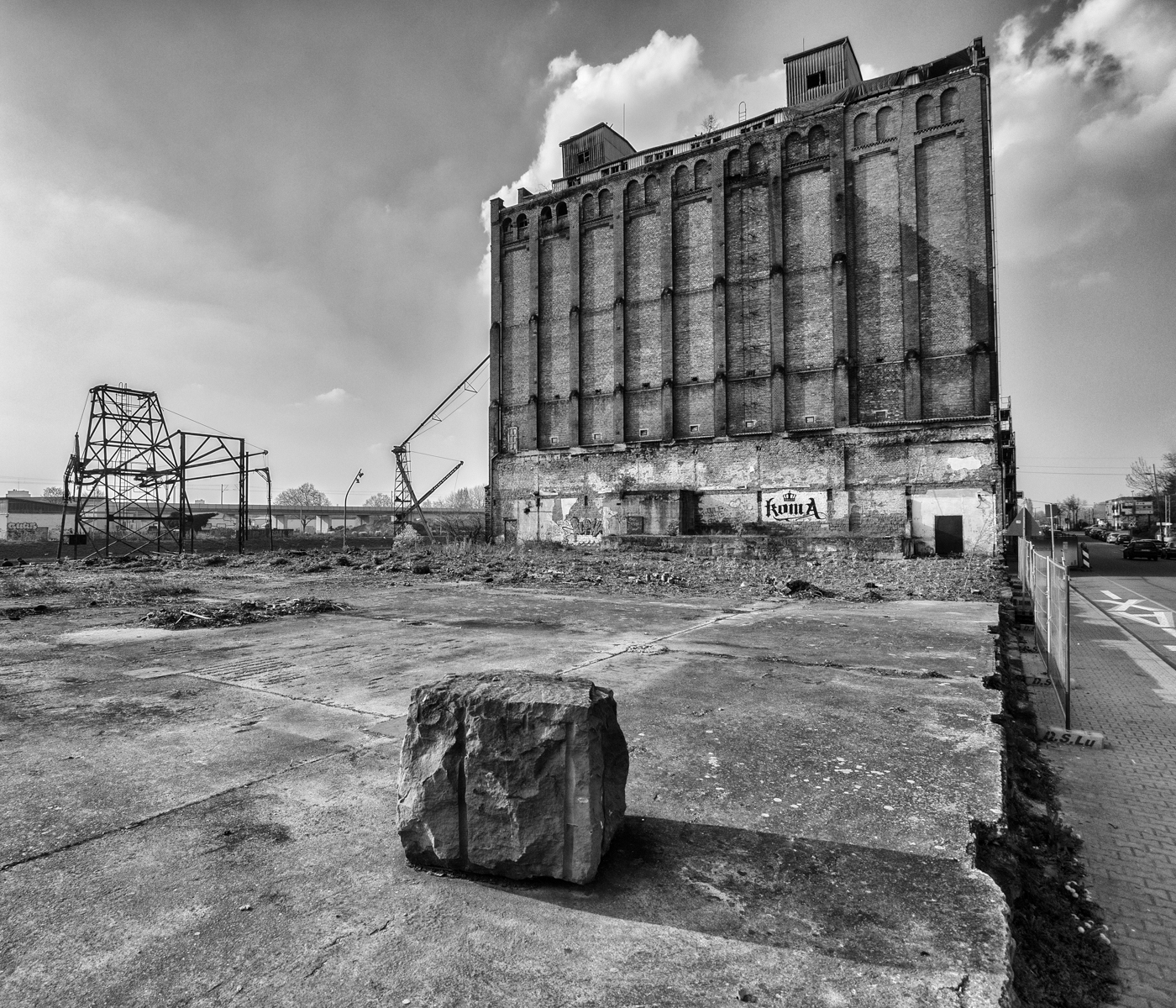
Wegweiser – Architektur, Konstruktion und Implementierung
Im dritten Teil des Wegweisers geht es um die Modellbeziehungen von Architektur, Konstruktion und Implementierung
Bild aus: Ralf Moser | Mannheim im Quadrat |
Der Würfel ist gefallen – Modell und Implementierung | 2010 |
[Alice, amüsiert]: Meinst Du, es bemerkt jemand, dass der Stein ein architektonisches Modell des Gebäudes sein könnte.
[Archi, schmunzelnd]: Dazu müssten sie zuerst die Ähnlichkeit in der geometrischen Form zwischen dem Gebäude und dem Stein bemerken. Meinst Du, dass viele den mathematischen Hintergrund von Architekturplänen verstehen? Obwohl sie im Alltag oft mit Gebäudeplänen zu tun haben, bin ich nicht sicher, dass sie die Dreitafelprojektion kennen oder ob sie beispielsweise den Modulor von Le Corbusier kennen und seine Bedeutung für die Architektur und für die Kunst kennen.
[Alice, belustigt]: Dann könnten sie auch sehen, dass der Modulor und die Perspektive in der Fotografie eine Rolle spielen kann, wenn es der Fotograf auf die klassische Schönheit des Goldenen Schnitts anlegt und sie für die Kommunikation der Fotografie nutzen will. Nein ich denke, sehr viele kennen die Dreitafelprojektion oder den Modulor nicht und nur wenige würden die Zusammenhänge mit der Kunst, der Fotografie und der Kommunikation sehen.
[Archi, verschmitzt]: Dann liegt noch viel Arbeit und noch mehr Denkzettel vor uns. Und sie müssen ganz, ganz einfach, zu verstehen sein.
[Alice, amüsiert]: Quasi ein Kinderspiel!
Mein christliches Testament
- Die Übel und die nötige Reformation
- Reformation und Transformation
- Glaubensbekenntnisse der Meisterarchitekten der Wandelhalle
Bild aus: Ralf Moser | Mein christliches Testament | Und erlöse uns von dem Übel | 2015
D er Wegweiser für kluge Avantgardisten ist nicht folgenlos für den Glauben. Er kann den Glauben durch unser Wissen begrenzen!
Lasset unser Wissen unseren Glauben begrenzen
Das Galilei-Problem trifft alle idealisierenden Religionen in ihrer feudalen Machtstruktur. Wie sehen die frohen Botschaften aus, wenn die feudale Machtstruktur einer Religion nicht den Sinn des Lebens bestimmt, sondern hilft, den Sinn im Leben zu finden?
Metalog der allwissenden Erzähler zum Eintritt ins Paradies |« M »| in der Stadt der Vernunft des lebenslangen Lernens
[Der allwissende Erzähler, inbrünstig, Ehrfurcht gebietend und fast schon erhaben]:
Lasst, die ihr eintretet, alle Hoffnungen fahren!
[Die allwissende Erzählerin, auf der Metametaebene erzählend]: Die allwissende Erzählerin schüttelt sich in der Rolle des allwissenden Erzählers vor Lachen, während sie sich den angeklebten Bart abnimmt.
[Die allwissende Erzählerin, auf der Metametaebene losprustend]: Keine Angst, ihr müsst in nichts eintreten!
[Die allwissende Erzählerin, jetzt ohne Bart aber erneut Ehrfurcht gebietend]:
Höret und Sehet!
Das ist gefährlich genug für eure unsterblichen Seelen.
[Die allwissende Erzählerin, auch auf der Metametaebene das Lachen unterdrückend]: Die allwissende Erzählerin prustet ohne Bart wieder los. Es entsteht erneut eine Pause, bis sie sich ans Publikum wendet.
[Die allwissende Erzählerin, auf der Metametametaebene vertraulich zum Publikum gewandt]: Verehrtes Publikum, es tut uns mir sehr leid, aber so etwas wollte er sie ich schon immer mal machen! Mit der Routine der professionellen Erzähler wollen wir jetzt zur geistigen Ruhe zurückfinden.
[Die allwissende Erzählerin, auf der Metaebene erzählend]: Ich dachte, ein solcher Anfang wäre für uns alle viel lustiger. Vielleicht seid ihr schon vor zu langer Zeit durch das Höllentor des klassischen Rationalismus gegangen, in dem es für ein Problem nur eine ideale Lösung gibt. Vielleicht waren die durchgestrichenen Worte und der Eintritt ins klassische Höllentor zu viel der göttlichen Komödie und eure unsterblichen armen Seelen warten schon zu lange darauf, vom Glück gefunden zu werden.
[Die allwissende Erzählerin, ehrfurchtgebietend]:
Verehrtes Publikum, Philosophen, Künstleringenieure, Künstlerarchitekten, Meisterarchitekten!
Hört mich an!
[Die allwissende Erzählerin, besorgt]: Bemerkt ihr noch, dass ihr, obwohl ihr glaubt, euch vom Idealismus befreit zu haben, nur durch das postmoderne Höllentor eines neuen Idealismus getreten seid? Jetzt schmort ihr in der postmodernen Vorhölle des idealen Vorgehens; denn euer methodisches Denken, eure Dekonstruktion, eure anderen Methoden und eure Sprachspiele sind immer noch eine ideale Lösung aus einer virtuellen Welt; daran wird weder die Dekonstruktion noch Sprachspiele etwas ändern.
Wollt ihr die Architektur des guten Lebens in der realen Welt verstehen und dazu lernen?
[Die allwissende Erzählerin, unsicher]: Seid ihr bereit, den klassischen Rationalismus und den Idealismus gehen zu lassen? Seid ihr bereit, auch das methodische Denken sein zu lassen und wieder dazu zu lernen?
[Die allwissende Erzählerin, ernst]: Wollt ihr vom Idealismus zur Ingenieurwissenschaft fortschreiten und eure Probleme wie ein Meister- und Künstlerarchitekt lösungsneutral aufstellen? Seid ihr bereit eure Entscheidungen selbstverantwortlich und vor allem selbst zu treffen?
[Die allwissende Erzählerin, spöttisch]: Oder zieht ihr in eine weitere, ideale Welt weiter: in Leonardos Welt, wie sie sich ein Idealist methodisch denkt, ohne die Ingenieurwissenschaft betrachtet, zitiert oder verstanden zu haben; ohne je den Unterschied zwischen wertend und durch Werturteile bevormundend verstanden zu haben. Oder wollt ihr etwas über die Architektur des guten Lebens lernen?
[Die allwissende Erzählerin, hoffnungsvoll]: Möge die Zeit der Meister- und Künstlerarchitekten wirklich gekommen sein! Mögen wir uns alle von Methoden und idealen Lösungen lösen und damit beginnen, unsere Probleme selbstverantwortlich und lösungsneutral aufzustellen! Vielleicht spielt dann das Geschlecht in der Tat keine Rolle mehr und ich kann meinen Bart für schlechte Zeiten weglegen!
[Die allwissende Erzählerin, lustvoll]: Die Geschichten des Testaments basieren auf der Architektur des Wissenstransfers des Wegweisers, das Wissen ohne Werturteile und ohne Bevormundung durch die Wissenschaft in die Praxis transferiert. Tretet durch das Mauseloch M ein in die Wandelhallen des ewigen Donners in der Stadt der Vernunft des lebenslangen Lernens. «Wandelhalle» ist der Name der Schule des Aristoteles in der Sprache der Stadt der Vernunft. Ihr griechischer Name ist «Peripatos». Alice und Archi schlendern auf das Mauseloch «M» und die Brücke des Carlo zu.
[Die allwissende Erzählerin, nachdenklich]: Einfach werden sie es nicht haben. Auch nach vierzigtausend Jahren geht eher ein Kamel durch ein Nadelöhr, als dass all die postmodernen Affen vom idealistischen Baum der Erkenntnis runterkommen. Auch heute hat es ein avantgardistischer Affe noch schwer, wenn er vom Baum steigt, den aufrechten Gang übt und eine neue, bessere Vernunft in der Steppe sucht!
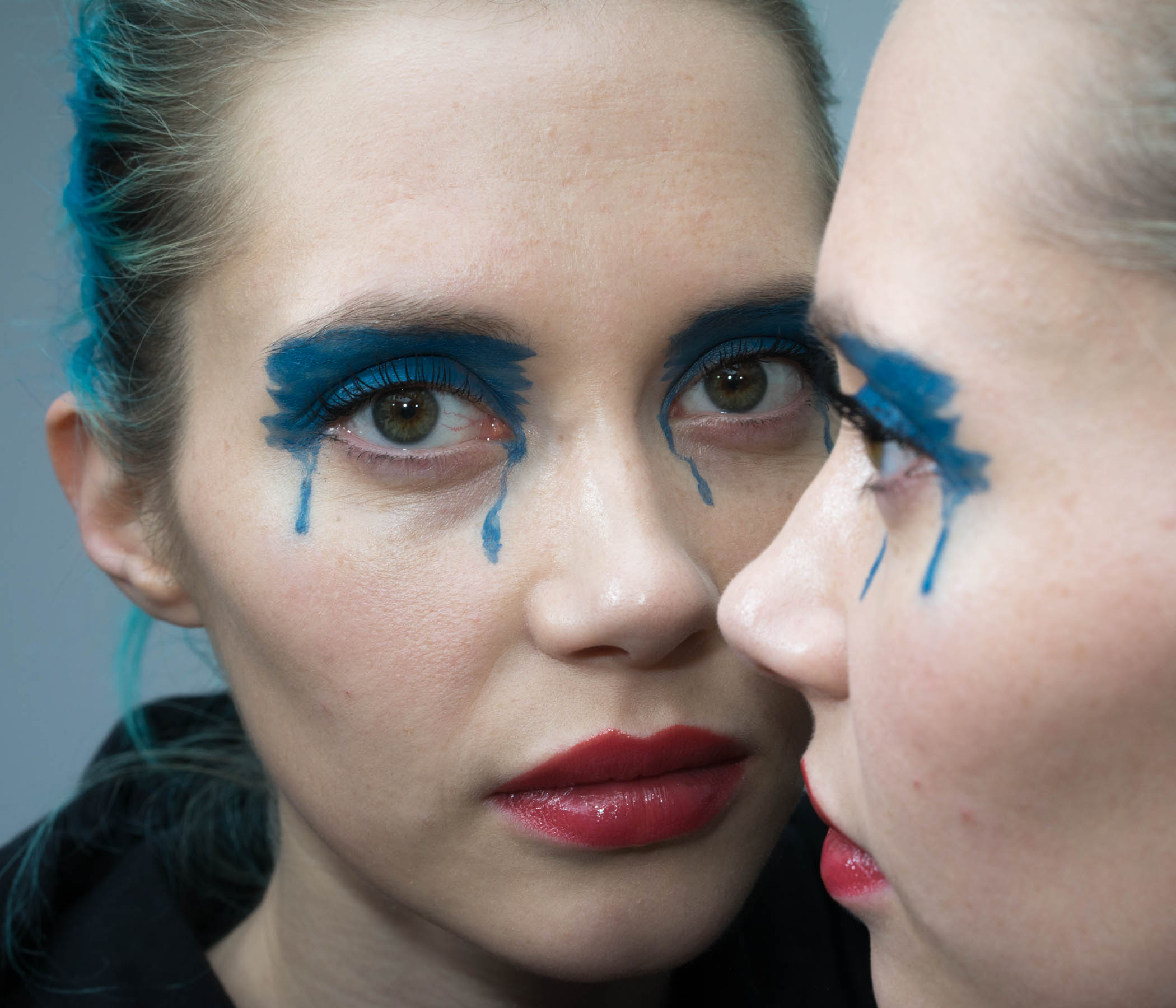
Mein christliches Testament
Das christliche Testament setzt sich mit den nach weiteren Reformen rufenden Teilen des christlichen Glaubens auseinander.
Bild aus: Ralf Moser | Mein christliches Testament | Und erlöse uns von dem Übel | 2015
[Alice, amüsiert]: Bei schönen Frauen bist Du doch normalerweise nicht auf den Mund gefallen. Da könntest Du doch die Geschichte erzählen, die Dir wie auf den Leib geschnitten ist. Eine mit A. und O. und der Schlange.
[Archi, nachdenklich]: Welche meinst Du?
[Alice, amüsiert]: Na, welche werde ich schon meinen. Alles muss man selber machen. Also erzähle ich sie selbst: Und so spielt die Geschichte mit den Kontexten von [A.] und [O.].
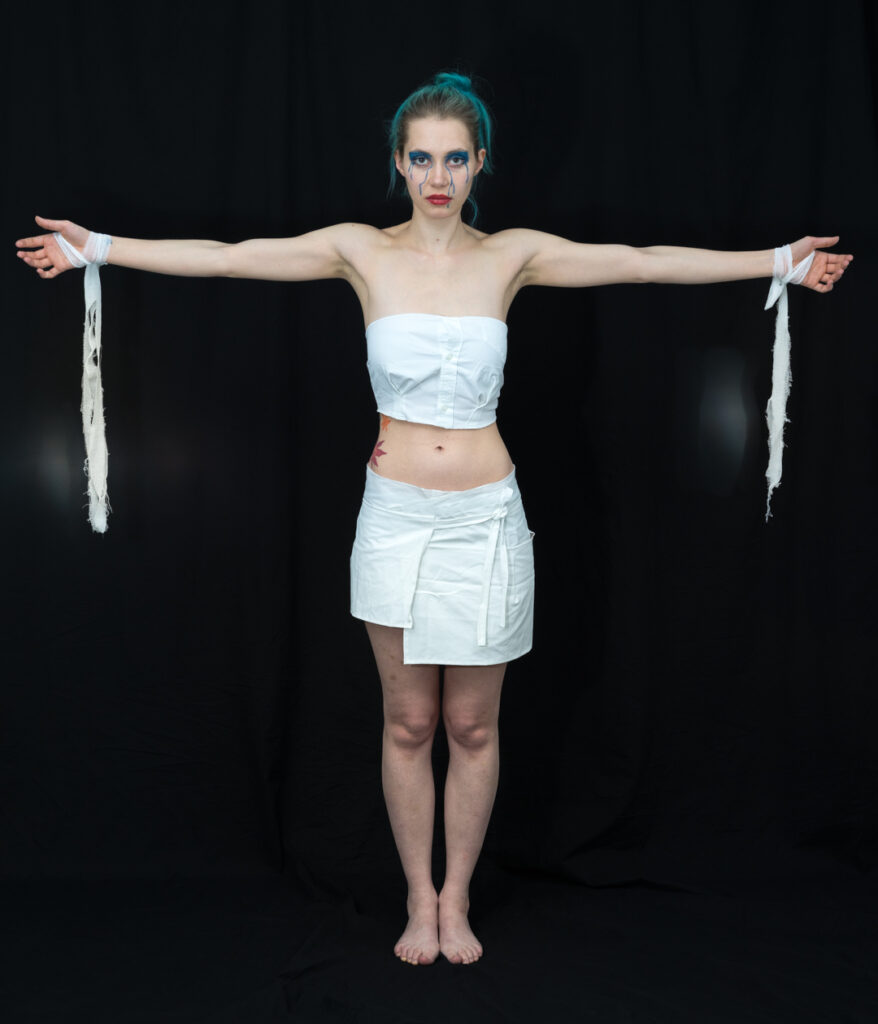
Ralf Moser | Mein christliches Testament | Und erlöse uns von dem Übel |
Der existenzialistische Stein des Anstoßes | 2015 |
[Alice, auf der Metaebene der Geschichte erzählend]:
A. müht sich in der Hitze des Mittags ab, einen Stein einen Berghang hinauf zu rollen. Kurz vorm Gipfel scheitert er immer wieder und der Stein rollt immer wieder zurück. Entkräftet setzt er sich in den Schatten des Steins als seine Frau O. eintrifft und ihm eine Stärkung bringt. Sie nimmt ein Brot aus dem mitgebrachten Korb, bricht es und hält A. das abgebrochene Stück Brot hin.
O. fürsorglich: «Ich habe einen Laib Brot mitgebracht. Möchtest Du ein Stück?»
A. nimmt das Stück Brot kraftlos entgegen und beißt wortlos ein Stück ab. Eine Schlange, die in einiger Entfernung im Grass liegt, hebt den Kopf, um die Szene besser beobachten zu können.
O.: verführerisch lächelnd : «Ich habe auch Wein und Trauben dabei. Möchtest Du?»
A. schüttelt den Kopf und lächelt ein wenig gequält.
O.: lächelnd: «Ja ich weiss, bei der Hitze tut es Dir nicht gut, mittags schon Wein zu kosten. Ein paar Trauben vielleicht?»
A. schüttelt erneut den Kopf und lächelt weniger gequält.
O.: verführerisch lächelnd: «Na dann vielleicht heute Abend.»
Na hoffentlich hat heute Abend nicht schon ein Anderer vom Würzwein und den Trauben gekostet, denkt sich die Schlange und kriecht näher, um besser sehen zu können. Warum muss der Kerl dauernd den Stein hoch und runter rollen. Das ist doch absurdes Theater!
O. interessiert: «Warum willst Du den Stein überhaupt auf den Berg schaffen? Da stellt man doch normalerweise ein Gipfelkreuz auf.»
A. setzt zu einer Antwort an, aber O. ist schneller.
O. besorgt, aber auch vorwurfsvoll: «Und wenn Du in der Hitze noch einen Schlag bekommst, dann bist Du heute abend wieder hundemüde und man kann nichts mehr mit dir anfangen.»
A. setzt erneut zu einer Antwort an, aber O. ist wieder schneller.
O. kämpferisch zu sich selbst redend: «Man muss sich heute nicht mehr selbst opfern. Wir können jetzt der Selektion der Natur mit anderen Mitteln begegnen und können unsere Erwartungen, unsere Ideen und unsere Vermutungen für uns sterben lassen.»
Popper, denkt die Schlange, Spätwerk, das mit den Welten.
A. überzeugt: «Dieser Fels gehört dem Herrn. Ich will ihn auf den Berg schaffen, dem Herrn ein neues Kunstwerk bauen und beten.»
Der war zu lange in der Sonne, denkt die Schlange und kriecht näher zu den Beiden hin. Der Stein soll wohl ein Readymade sein. Evangelisch, denkt sich die Schlange, zu hartes Brot für einen Katholiken.
A. schaut O. an, aber O. hängt noch ihren eigenen Gedanken nach. In Gedanken wär der Stein in Nullkommanichts oben, denkt sie.
O. nachdenklich nach der Funktion fragend: «Wozu?»
Als sie A.’s fragendes Gesicht sieht, korrigiert sie sich.
O. in A.’s Weltbild nach dem Grund fragend: «Warum?»
A.: «Ich nehme meinen selbstgewählten Gott in selbstgewählter Weise an, unterwerfe mich ihm und folge ihm nach. Das ist doch auch die Grundlage unseres Paktes. Wir erfüllen in Freiheit die Regeln, welche die Gesellschaft an uns stellt; aber wir sind frei unser Schicksal anzunehmen. Wenn wir es ablehnen, gehen wir aus freien Stücken in den Tod.»
Ein evangelischer Existentialist, denkt die Schlange. Der hat bestimmt Angst vor Veränderungen, weil er von den vielen Möglichkeiten überfordert ist und jede Entscheidung auf die Goldwaage legt.
O.: «Hat die Realität in deinen Gedanken nicht das falsche Gewicht? Sollte da nicht mehr Hoffnung auf Veränderung sein?»
Die Kleine hat’s auch kapiert, denkt die Schlange. Und sie kennt Murakami, kluges Kind.
A.: «Vielleicht wird es dann schlechter. Vielleicht wird es dann nie wieder Gut.»
Hab ich es mir doch gedacht, denkt die Schlange, ein Existenzialist, den man einfach so in die böse Welt geworfen hat.
O.: «Vielleicht würde es uns besser gehen! Vielleicht riskierst Du zu wenig. Vielleicht fühlst Du auch nicht diese unbändige Lust auf Veränderung. Ist es nicht besser, wenn sich einfach mal was ändert?»
A. schaut unglücklich auf seinen Stein. O. steht auf und sammelt sich.
Für den ist nur weitermachen einfach, denkt sich die Schlange.
O. bittend: «Komm nicht zu spät nach Hause, damit wir uns noch einen schönen Abend machen können.»
A. zuversichtlich: «Ich probier’s nur noch einmal.»
O. wendet sich ab und geht. A. entspannt sich und sieht verträumt ins Leere. Die Schlange kriecht neugierig heran.
Schlange Besorgnis heuchelnd: «Wohin geht die Kleine so alleine?»
A. überrumpelt: «Nach hause.»
Schlange vorwurfsvoll: «Und was machst Du noch hier?»
A.: «Ich stimme mich mental darauf ein, den Stein auf den Berg zu rollen. Ich hab mir vorgestellt, ich steh oben mit meinem Stein auf dem Gipfel.»
Jetzt sitzt er da mit seinem Stein und träumt sogar noch davon, ihn auf den Berg zu rollen, denkt sich die Schlange kopfschüttelnd. Ohne die Kleine würde der noch im Paradies sitzen, saufen und Fußball glotzen. Kein Wunder dass, die Kleine ständig das Gefühl kriegt, sie muss da raus.
Die Schlange sitzt immer noch kopfschüttelnd vor A., als der sich abwendet und demütig den Blick senkt.
A.: «Und erlöse uns von dem Übel.»
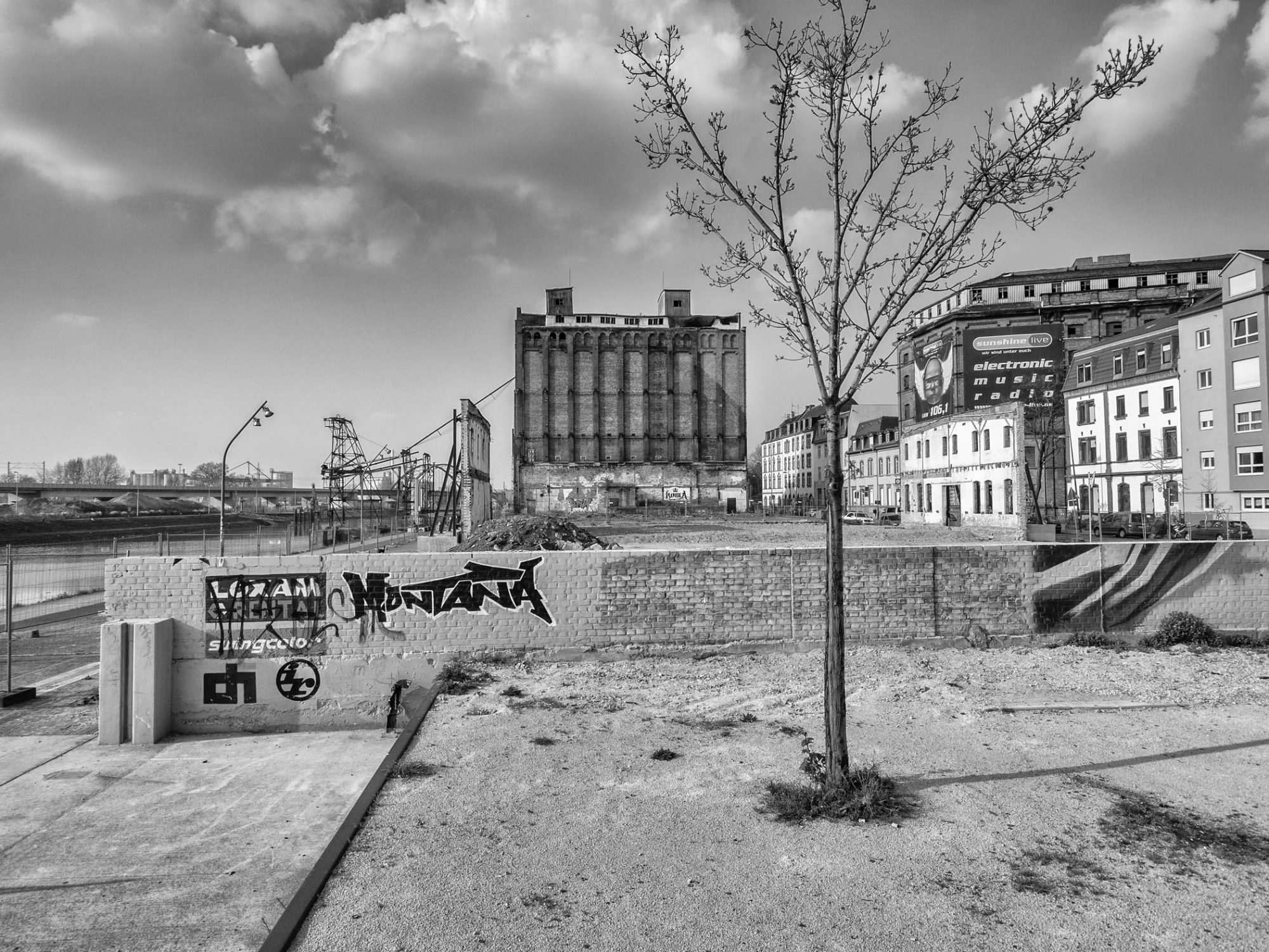
Ateliers im Delta
Seit 2010 – Ateliers zwischen Wissenschaft und Kunst
Bild aus: Ralf Moser | Ateliers im Delta | 2010 |
Ateliers im Delta
Seit 2010 – Ateliers zwischen Wissenschaft und Kunst
Hannah und Ralf Moser sind die Köpfe, die hinter den Ateliers im Delta stecken. Sie sind beide geschäftsführende Gesellschafter der Ateliers im Delta (AiD) Kunstbetrieb GmbH und der Ateliers im Delta (AiD) gGmbH. Zusammen haben sie für beide Gesellschaften die Mannheimer Erklärung für ein Zusammenleben in Vielfalt unterschrieben. Zusammen haben sie das Manifest M verfasst, das die Ateliers im Delta definiert.

